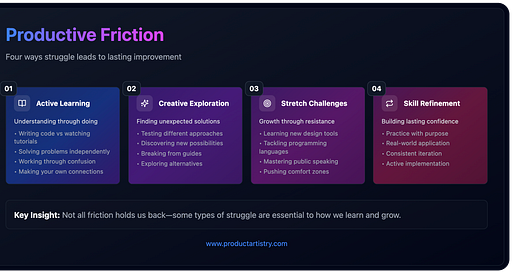The Friction Paradox
I love AI tools today, but I'm glad they weren't around during my university years. I often think about how different my experience and path would have been if I had been at university now.
It's a strange thing to say, isn't it?
In an era where we celebrate innovations that make life easier, being thankful for doing things the hard way feels counterintuitive.
But here’s the thing: Learning isn't supposed to be easy. The resistance we feel when wrestling with a new concept, the frustration of solving a tough problem—these aren't bugs in the learning process. They're features.
Looking back on my journey into product, the moments that shaped me weren't when everything clicked smoothly into place. They were the times I pushed through uncertainty, wrestled with complexity, and failed before succeeding.
Those struggles didn't just teach me design skills—they shaped how I think about helping others solve real problems.
The Power of Productive Struggle
In my early days conducting product demos, I noticed a fascinating pattern. Polished presentations, where I explained everything step-by-step, left users nodding in understanding. But in follow-ups, it was as if they'd never seen the product before. The information hadn't stuck.
Everything changed when I flipped the script and let users drive. I guided them through a screenshare while they explored. It was slower and messier, but the difference was striking: not only did they remember how things worked, but they also felt confident enough to tackle problems on their own.
This experience revealed a deeper truth: in our rush to eliminate friction and maximize convenience, we might be sacrificing something essential—the resistance that helps us truly understand and master new skills.
While reducing friction often makes sense in sales and marketing, building products that truly help people learn and grow requires a different approach. In these cases, some resistance isn't just inevitable—it's essential for meaningful progress.
Understanding Value-Creating Friction
Not all friction is created equal. Some things really do just get in our way, while others push us to think deeper and learn better. The challenge isn’t making everything easy—it’s figuring out where a bit of struggle actually helps.
Here are four ways I’ve found that friction fosters learning and improvement:
1. Active Learning
True understanding comes from working through problems ourselves. It’s the difference between watching someone code and writing your own program, between seeing someone use a tool and figuring it out yourself. Yes, it’s slower. Yes, it’s harder. But that’s exactly why it works. When you have to connect the dots or work through confusion, you build knowledge that lasts.
2. Creative Exploration
Unexpected solutions come when we have room to explore. When using products, we often follow a predefined path. But when we have space to test ideas and try different approaches, we discover better ways to solve problems. It’s messier than following a guide, but it leads to creative breakthroughs.
3. Stretch Challenges
Growth happens when we push beyond our comfort zones. Learning a new design tool, tackling a programming language, or mastering public speaking—these challenges build lasting skills. Struggle is the engine of improvement.
4. Skill Refinement
Confidence comes from practice. Understanding something conceptually is one thing; using it effectively when it matters is another. Through repetition and active use, we turn knowledge into reliable skills.
Rethinking Our Approach
I recently experienced this from the other side when I created Dark Patterns Detective, an educational game about deceptive UX practices. When the game gained organic traction, nearly 2,000 people engaged in a single day—despite, or perhaps because of, its intentional friction.
Instead of passively consuming information, players had to think, engage, and solve problems. The feedback was clear: those challenges made the learning stick. In a world where we often forget what we scroll through mere moments later, the game’s friction created a memorable experience.
Instead of asking, "How can we make this easier?" we should ask:
Where does embracing difficulty lead to deeper learning?
What types of challenges drive meaningful improvement?
How can we inspire people to engage more deeply with the process?
When does overcoming resistance create lasting value?
The Path Forward
This doesn't mean making things needlessly difficult. The goal isn't to add friction for its own sake, but to be thoughtful about where a bit of resistance helps people get better at what they're trying to do.
As AI and automation advance and continue to “eat the world”, this becomes even more important. We need to be careful about preserving the kinds of challenges that help people learn and improve, while removing the ones that just waste their time and energy.
In the end, our goal isn't just to make things easier—it's to build tools that help people thrive. And sometimes, thriving means embracing the productive struggle that leads to real learning.
Thanks for reading!
How you Can Support Product Artistry:
If you’ve found value in these ideas, there are three simple ways to support this work:
Like and Share: Spread these ideas to others who might benefit from them.
Subscribe for Free: Get future posts delivered straight to your inbox.
Become a Paid Subscriber: Support my independent journey and help sustain Product Artistry.
Let’s Connect:
I’d love to hear from you! Connect with me on LinkedIn, Bluesky, Threads, X, or drop me an Email. I’m always open to interesting discussions and collaborations.
Keep Iterating,
—Rohan






Well put. It's through the struggling that we learn. Not the cut and pasting. I too like AI and have used it to help me. But I fear critical thinking/learning is going to suffer.